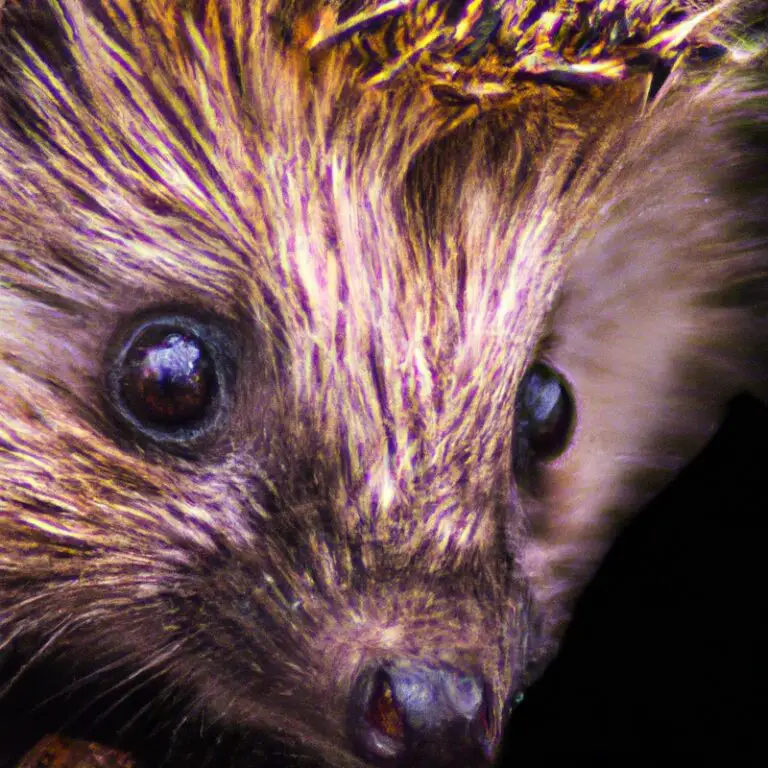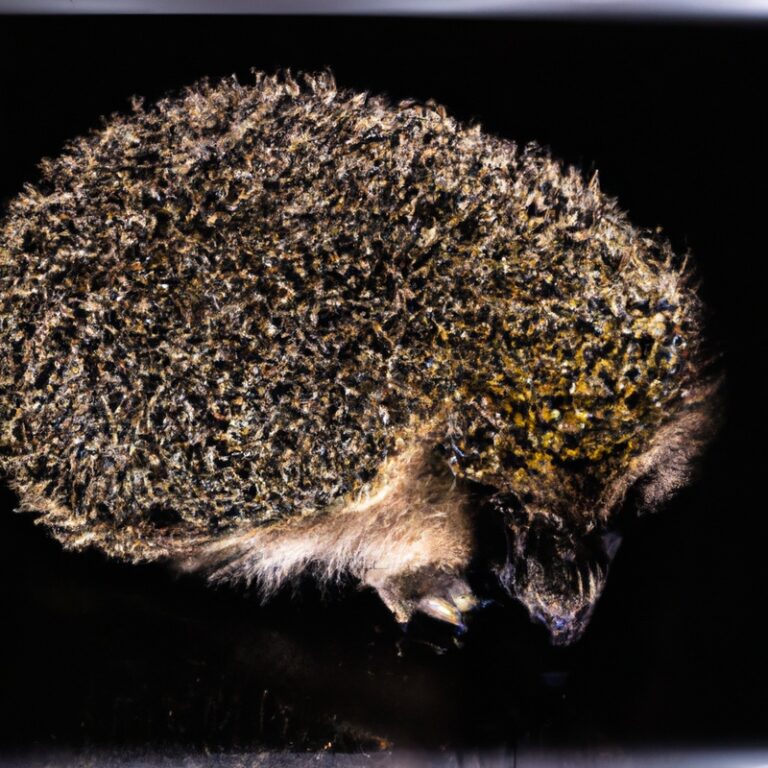How To Provide a Safe Passage For Hedgehogs Across Roads?
Key Takeaways:
- Install hedgehog-friendly road barriers to prevent hedgehogs from crossing dangerous roads.
- Create dedicated hedgehog tunnels under roads to ensure their safe passage.
- Maintain natural habitats near roads to discourage hedgehogs from venturing onto busy streets.
- Raise awareness and educate the public on the importance of protecting hedgehogs and providing safe road crossings.
Do you ever pause and marvel at the sight of a hedgehog meandering through a lush garden or forest? These adorable creatures have captured the hearts of many with their spiky exteriors and gentle nature.
However, these intrepid explorers face a grave danger when venturing onto our roads.
As someone keen on preserving our natural world, you may be wondering how you can protect our hedgehog friends from the perils of traffic. In this article, we will delve into the importance of providing safe passages for hedgehogs, assess the risks they face on roads, and explore effective measures to ensure their safe journey.
So, let’s embark on this hedgehog-saving adventure together!
| Methods | Pros | Cons |
| Installing wildlife tunnels or culverts | – Provides a safe and direct passage for hedgehogs – Reduces the risk of road accidents involving hedgehogs – Can be used by other wildlife as well | – Requires cost and effort for installation and maintenance – Landowners’ approval may be needed for construction – May not be suitable for all road locations |
| Creating hedgehog-friendly road features | – Allows hedgehogs to crawl under fences or barriers – Provides alternative routes for hedgehogs to cross roads – Can be incorporated into existing road infrastructure | – Requires infrastructure modification and ongoing maintenance – May not be effective if not properly designed and implemented |
| Installing wildlife-friendly road signs | – Increases awareness among drivers and encourages caution – Promotes consideration for hedgehogs and other wildlife | – Relies on drivers’ compliance and awareness – May not directly prevent hedgehog road accidents |
Understanding the Importance of Providing Safe Passages for Hedgehogs
Providing safe passages for hedgehogs is vital for their survival and conservation efforts.
The Vulnerability of Hedgehogs on Roads
Hedgehogs are highly vulnerable to road accidents.
Their small size and slow movements make them easy targets for vehicles.
Lack of awareness and low visibility also contribute to the danger they face on roads.
To protect hedgehogs, it is important to drive cautiously, especially at night when they are most active.
Creating safe passages such as tunnels or underpasses can also help hedgehogs safely cross roads.
By being mindful of their vulnerability and taking appropriate measures, we can ensure the safety of these adorable creatures.

The Importance of Conserving Hedgehog Populations
Conserving hedgehog populations is crucial for maintaining a healthy ecosystem. Hedgehogs play an important role in controlling pests such as slugs and insects, helping to maintain balance in the local environment.
Additionally, hedgehogs are a vital part of our natural heritage and a valuable indicator of the health of our ecosystems.
By protecting hedgehog habitats and creating safe spaces for them to live and breed, we can ensure the survival of these fascinating creatures for future generations to enjoy.
Assessing the Risk Factors for Hedgehogs on Roads
To ensure a safe passage for hedgehogs, it’s important to assess the risk factors they face on roads.
Identifying High-Risk Areas for Hedgehogs
To identify high-risk areas for hedgehogs, pay attention to the following factors:
- Road type: Hedgehogs are more likely to be at risk on busy roads with higher speeds and multiple lanes.
- Habitat proximity: Areas close to hedgehog habitats, such as green spaces or woodland, are often high-risk zones.
- Urban areas: City streets and residential neighborhoods can pose significant dangers due to increased traffic and artificial lighting.
- Crossing points: Look for areas where road features, such as hedges or ditches, act as natural crossing points for hedgehogs.
- Previous incidents: Check local records or speak with wildlife rescue organizations to determine areas with a history of hedgehog road casualties.
By considering these factors, you can identify high-risk areas and take proactive steps to protect hedgehogs and reduce their vulnerability to road accidents.

Understanding Hedgehog Behavior on Roads
Understanding Hedgehog Behavior on Roads Hedgehogs on roads tend to display certain behaviors that can help us understand how to better protect them. They are primarily nocturnal creatures, so they are more active during the night when traffic is higher.
Hedgehogs have a natural instinct to curl up into a ball when they feel threatened, which unfortunately makes them more vulnerable to being run over.
They also have a tendency to use the same travel routes repeatedly, which means they may become accustomed to certain road crossings. By taking these behaviors into account, we can implement measures to provide safe crossings for hedgehogs, such as installing wildlife underpasses or signage to warn drivers.
Implementing Measures to Provide Safe Passages for Hedgehogs
To ensure safe passage for hedgehogs, take these measures: create hedgehog-friendly gardens, install tunnels and fencing, and spread awareness in local communities.
Creating Hedgehog-Friendly Gardens
Creating a hedgehog-friendly garden is easier than you might think.
Here are some simple steps you can take:
- Provide shelter: Leave areas of your garden wild and untidy, with piles of leaves or logs for hedgehogs to hide in.
- Create highways: Cut a small hole in your garden fence or wall to allow hedgehogs to move between gardens.
- Offer food and water: Leave out shallow dishes of fresh water and provide a hedgehog-friendly food source, such as wet cat or dog food.
- Avoid hazards: Remove slug pellets, keep your garden free of litter, and check before strimming or mowing to avoid harming hedgehogs.
By taking these steps, you can help create a safe and welcoming environment for hedgehogs in your garden.
Installing Hedgehog Tunnels and Fencing
To provide safe passages for hedgehogs across roads, installing hedgehog tunnels and fencing is an effective solution.
Hedgehog tunnels are small structures that go under or over roads, allowing hedgehogs to safely cross without encountering traffic.
Fencing can be used to guide hedgehogs towards these tunnels, preventing them from wandering onto the road.
This helps protect hedgehogs from accidents and ensures their safe movement between different habitats.
By implementing these measures, we can create a safer environment for these adorable creatures.
Spreading Awareness in Local Communities
Spreading awareness in local communities about the importance of providing safe passages for hedgehogs is essential.
Here are some simple ways you can do it:
- Talk to your neighbors: Engage in conversations with people in your community about hedgehog conservation and the need to protect their habitats.
- Share information: Use social media platforms, community notice boards, and local newsletters to spread information about hedgehog-friendly practices, such as creating hedgehog holes in fences and reducing the use of pesticides.
- Organize workshops or events: Arrange workshops or events in collaboration with local organizations or wildlife experts to educate the community about hedgehog conservation. This can include talks, demonstrations, and hands-on activities.
- Engage schools and youth groups: Reach out to schools and youth organizations to conduct educational sessions about hedgehogs and their habitat needs. Encourage them to take action by creating hedgehog-friendly spaces in their gardens or school premises.
- Create local initiatives: Establish local initiatives or groups that focus on hedgehog protection. This can involve organizing volunteer efforts to maintain hedgehog-friendly areas, conducting regular surveys, or advocating for hedgehog-friendly policies in your community.
By actively spreading awareness in your local community, you can make a significant difference in ensuring safer passages for hedgehogs and protecting their populations for future generations to enjoy.
Guidelines for Drivers to Help Hedgehogs Cross Roads Safely
Help hedgehogs cross roads safely by driving cautiously, keeping an eye out for them, and allowing them to pass without interruption.
Recognizing Hedgehogs on the Road
Recognizing Hedgehogs on the Road is important for their safety.
Look out for their small size, round shape, and spiky appearance.
They may be crossing slowly or curled up in a defensive position.
Keep an eye out especially at dusk and dawn when they are most active.
Slow down and give them space to cross safely.
Avoid honking or flashing your lights as it may startle them.
Help protect these adorable creatures by being aware and cautious when driving.
Acting Responsibly When Encountering a Hedgehog
When you encounter a hedgehog, it’s important to act responsibly to ensure its safety. Here’s what you can do:
- Slow down or stop if you see a hedgehog on the road, and give it time to cross safely.
- If it’s safe to do so, gently herd the hedgehog off the road in the direction it’s heading.
- Avoid using your horn or flashing lights, as these can startle and disorient the hedgehog.
- Never try to pick up a hedgehog with your bare hands, as they have spines that can cause injury.
- If you’re concerned about the hedgehog’s welfare, you can contact a local wildlife rescue organization for assistance.
Reporting Injured or Deceased Hedgehogs
If you come across an injured or deceased hedgehog on the road, it’s important to take action.
Here’s what you can do:
- For an injured hedgehog:
- Contact your local wildlife rescue organization or animal control.
- Use gloves and a towel to carefully pick up the hedgehog and place it in a ventilated box with bedding and a shallow dish of water.
- Keep the hedgehog warm and calm while waiting for help to arrive.
- For a deceased hedgehog:
- Move it to the side of the road, if safe, to prevent further accidents.
- Report the sighting to your local wildlife authorities, who may collect the hedgehog for research or to determine cause of death.
- Avoid touching the hedgehog without gloves, as they can carry diseases.
Remember, your actions can make a difference in protecting hedgehogs and ensuring their well-being.
Collaborating with Local Authorities and Organizations
Collaborate with local authorities and organizations for effective hedgehog protection.
Advocating for Hedgehog Protection Laws and Policies
Advocating for hedgehog protection laws and policies is essential in ensuring the conservation of these adorable creatures.
By working closely with local authorities and organizations, you can make a difference.
Write letters and emails to your representatives, urging them to support legislation that protects hedgehog habitats and imposes penalties for harming them.
Collaborate with wildlife organizations to raise awareness and engage in educational campaigns.
By actively advocating for hedgehog protection, you can contribute to their safety and well-being.
Working with Road Maintenance Agencies
When working with road maintenance agencies to provide a safe passage for hedgehogs, communication is key. Start by reaching out to the agency in your area and explain your concerns about hedgehog safety on the roads.
Offer to collaborate and share any relevant research or resources that could help them implement measures such as installing wildlife-friendly road signs or creating wildlife corridors.
Regularly follow up and maintain positive communication to ensure the well-being of hedgehogs on the roadways.
Frequently Asked Questions (FAQs)
How do hedgehogs end up on roads?
Hedgehogs end up on roads mainly due to their natural foraging habits and the fragmentation of their habitats caused by roads.
They often venture out at night to search for food, and unfortunately, roads may intersect with their foraging routes.
Hedgehogs have a poor sense of direction and can easily become disoriented, leading them onto roads where they become vulnerable to traffic.
Additionally, the presence of hedgerows and green spaces near roads can attract hedgehogs, increasing the likelihood of encounters with vehicles.
Are hedgehogs nocturnal or active during the day?
Hedgehogs are primarily nocturnal creatures, meaning that they are most active during the night time.
This is when they venture out in search of food, mates, and territory.
They have excellent night vision and acute hearing, which helps them navigate and find prey in the dark.
During the day, hedgehogs tend to sleep or rest in a safe location, such as under bushes or in piles of leaves, to avoid predators.
So, if you happen to spot a hedgehog during the day, it may be a sign that it is in distress or unwell.
What can be done to prevent hedgehog road casualties?
To prevent hedgehog road casualties, there are a few simple things you can do:
- Slow down when driving at night, especially in rural areas where hedgehogs may be more prevalent.
- Install hedgehog-friendly fencing along roadsides to guide them away from danger.
- Create small gaps or tunnels in fences to allow hedgehogs to pass through safely.
- Check long grass and shrubs before using a lawnmower or strimmer to avoid injuring any hidden hedgehogs.
- Raise awareness in your community about the importance of protecting hedgehogs and their habitats.
Final Verdict
Providing safe passages for hedgehogs across roads is crucial for conserving their populations and preventing unnecessary casualties.
By identifying high-risk areas and understanding hedgehog behavior on roads, we can implement effective measures such as creating hedgehog-friendly gardens, installing tunnels and fencing, and spreading awareness in local communities.
It is equally important for drivers to recognize and responsibly navigate hedgehogs on the road, while reporting any injured or deceased individuals.
Collaboration with local authorities, wildlife conservation groups, and road maintenance agencies is key to achieving long-term success in hedgehog road safety.
Let us come together to protect these enchanting creatures and ensure their peaceful journeys.







